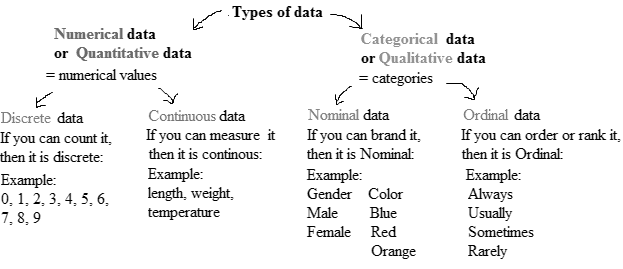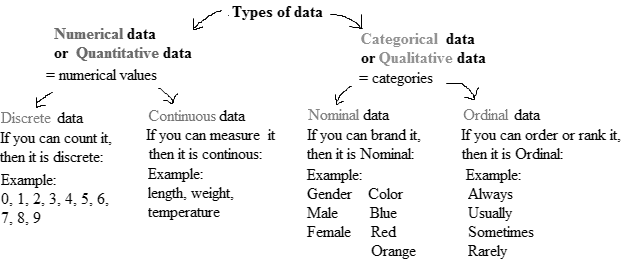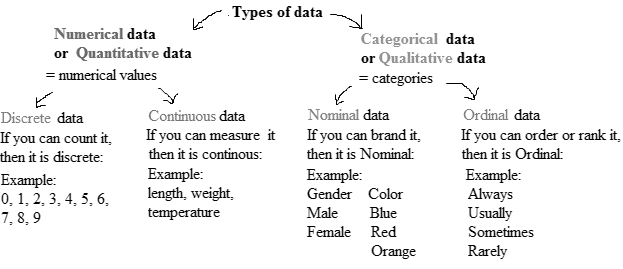
At the movies: The following table provides information about the top grossing movies of all time.


- Which of the columns represent qualitative variables?
- Which of the columns represent quantitative variables?
- Which of the columns represent nominal variables?
- Which of the columns represent ordinal variables?
a.
To identify:the columns that represent qualitative variables.
Answer to Problem 48E
The columns Movie Title and Genre represent qualitative variables.
Explanation of Solution
Given information:
| Movie Title | Release Year | Genre | Ticket Sales (millions of $) | Running Time (minutes) |
| 1. Star Wars Episode VII: The Force Awakens | 2015 | Adventure | 936 | 136 |
| 2. Avatars | 2009 | Action | 761 | 162 |
| 3. Titanic | 1997 | Historical Fiction | 659 | 194 |
| 4. Jurassic World | 2015 | Action | 652 | 124 |
| 5. The Avengers | 2012 | Adventure | 623 | 143 |
| 6. The Dark Knight | 2008 | Action | 533 | 152 |
| 7. Star Wars Episode I: The Phantom Menace | 1999 | Adventure | 475 | 133 |
| 8. Star Wars Episode IV: A New Hope | 1977 | Adventure | 461 | 119 |
| 9. Avengers: Age of Ultron | 2015 | Action | 459 | 141 |
| 10. The Dark Knight | 2012 | Action | 448 | 164 |
Concept Involved:
There are various methods of collecting information by sampling. Once the information has been collected, the collection is called a data set. Variables can be divided into two types: qualitative and quantitative. Qualitative variables are also called categorical variable, classify individuals into categories. Quantitative variables are numerical and tell how much of something there is.
Qualitative variables come in two types: ordinal variables and nominal variables.
Ordinal variables are qualitative variables whose categories have a natural ordering.
Nominal variables are qualitative variables whose categories have no natural ordering.
Quantitative variables can be either discrete or continuous.
Discrete variables are those whose possible values can be listed. Often, discrete variables result from counting something, so the possible values of the variable are 0, 1, 2 and so forth.
Continuous variables can, in principle, take on any value within some interval.

The variable which classifies individuals into categories is called qualitative variable, and the variable which provide information about quantity or number of something is quantitative variable. The Movie Title and Genre classifies the top grossing movies of all time.
Therefore, the columns Movie Title and Genre represent qualitative variables.
b.
To identify:the columns that represent quantitative variables.
Answer to Problem 48E
The columns Ticket Sales (millions of $) and Running Time (minutes) represent quantitative variables.
Explanation of Solution
Given information:
| Movie Title | Release Year | Genre | Ticket Sales (millions of $) | Running Time (minutes) |
| 1. Star Wars Episode VII: The Force Awakens | 2015 | Adventure | 936 | 136 |
| 2. Avatars | 2009 | Action | 761 | 162 |
| 3. Titanic | 1997 | Historical Fiction | 659 | 194 |
| 4. Jurassic World | 2015 | Action | 652 | 124 |
| 5. The Avengers | 2012 | Adventure | 623 | 143 |
| 6. The Dark Knight | 2008 | Action | 533 | 152 |
| 7. Star Wars Episode I: The Phantom Menace | 1999 | Adventure | 475 | 133 |
| 8. Star Wars Episode IV: A New Hope | 1977 | Adventure | 461 | 119 |
| 9. Avengers: Age of Ultron | 2015 | Action | 459 | 141 |
| 10. The Dark Knight | 2012 | Action | 448 | 164 |
Concept Involved:
There are various methods of collecting information by sampling. Once the information has been collected, the collection is called a data set. Variables can be divided into two types: qualitative and quantitative. Qualitative variables are also called categorical variable, classify individuals into categories. Quantitative variables are numerical and tell how much of something there is.
Qualitative variables come in two types: ordinal variables and nominal variables.
Ordinal variables are qualitative variables whose categories have a natural ordering.
Nominal variables are qualitative variables whose categories have no natural ordering.
Quantitative variables can be either discrete or continuous.
Discrete variables are those whose possible values can be listed. Often, discrete variables result from counting something, so the possible values of the variable are 0, 1, 2 and so forth.
Continuous variables can, in principle, take on any value within some interval.

The variable which classifies individuals into categories is called qualitative variable, and the variable which provide information about quantity or number of something is quantitative variable. The Tickets Sales (millions of $) and Running Time (minutes) represent how many of something of there is present.
Therefore, these columns represents quantitative variable.
c.
To identify:the columns that represent nominal variables.
Answer to Problem 48E
The columns Genre represent nominal variables.
Explanation of Solution
Given information:
| Movie Title | Release Year | Genre | Ticket Sales (millions of $) | Running Time (minutes) |
| 1. Star Wars Episode VII: The Force Awakens | 2015 | Adventure | 936 | 136 |
| 2. Avatars | 2009 | Action | 761 | 162 |
| 3. Titanic | 1997 | Historical Fiction | 659 | 194 |
| 4. Jurassic World | 2015 | Action | 652 | 124 |
| 5. The Avengers | 2012 | Adventure | 623 | 143 |
| 6. The Dark Knight | 2008 | Action | 533 | 152 |
| 7. Star Wars Episode I: The Phantom Menace | 1999 | Adventure | 475 | 133 |
| 8. Star Wars Episode IV: A New Hope | 1977 | Adventure | 461 | 119 |
| 9. Avengers: Age of Ultron | 2015 | Action | 459 | 141 |
| 10. The Dark Knight | 2012 | Action | 448 | 164 |
Concept Involved:
There are various methods of collecting information by sampling. Once the information has been collected, the collection is called a data set. Variables can be divided into two types: qualitative and quantitative. Qualitative variables are also called categorical variable, classify individuals into categories. Quantitative variables are numerical and tell how much of something there is.
Qualitative variables come in two types: ordinal variables and nominal variables.
Ordinal variables are qualitative variables whose categories have a natural ordering.
Nominal variables are qualitative variables whose categories have no natural ordering.
Quantitative variables can be either discrete or continuous.
Discrete variables are those whose possible values can be listed. Often, discrete variables result from counting something, so the possible values of the variable are 0, 1, 2 and so forth.
Continuous variables can, in principle, take on any value within some interval.

The values are classified into categories in a nominal variable, but no natural ordering is there in categories, whereas, the values are also classified into categories in an ordinary variable but a natural ordering is there in categories.
Therefore, the Genre column has categories but doesn’t have natural ordering.
d.
To identify:the columns that represent ordinal variables.
Answer to Problem 48E
The column Movie Title represent ordinal variables.
Explanation of Solution
Given information:
| Movie Title | Release Year | Genre | Ticket Sales (millions of $) | Running Time (minutes) |
| 1. Star Wars Episode VII: The Force Awakens | 2015 | Adventure | 936 | 136 |
| 2. Avatars | 2009 | Action | 761 | 162 |
| 3. Titanic | 1997 | Historical Fiction | 659 | 194 |
| 4. Jurassic World | 2015 | Action | 652 | 124 |
| 5. The Avengers | 2012 | Adventure | 623 | 143 |
| 6. The Dark Knight | 2008 | Action | 533 | 152 |
| 7. Star Wars Episode I: The Phantom Menace | 1999 | Adventure | 475 | 133 |
| 8. Star Wars Episode IV: A New Hope | 1977 | Adventure | 461 | 119 |
| 9. Avengers: Age of Ultron | 2015 | Action | 459 | 141 |
| 10. The Dark Knight | 2012 | Action | 448 | 164 |
Concept Involved:
There are various methods of collecting information by sampling. Once the information has been collected, the collection is called a data set. Variables can be divided into two types: qualitative and quantitative. Qualitative variables are also called categorical variable, classify individuals into categories. Quantitative variables are numerical and tell how much of something there is.
Qualitative variables come in two types: ordinal variables and nominal variables.
Ordinal variables are qualitative variables whose categories have a natural ordering.
Nominal variables are qualitative variables whose categories have no natural ordering.
Quantitative variables can be either discrete or continuous.
Discrete variables are those whose possible values can be listed. Often, discrete variables result from counting something, so the possible values of the variable are 0, 1, 2 and so forth.
Continuous variables can, in principle, take on any value within some interval.

The values are classified into categories in a nominal variable, but no natural ordering is there in categories, whereas, the values are also classified into categories in an ordinary variable but a natural ordering is there in categories. The variable movie title classifies the top grossing movies of all time.
Therefore, column Movie Title represents ordinal variables.
Want to see more full solutions like this?
Chapter 1 Solutions
Connect Hosted by ALEKS Online Access for Elementary Statistics
- 1- Let A = {A1, A2, ...), in which A, A, = 0, when i j. a) Is A a π-system? If not, which element(s) should be added to A to become a π-system? b) Prove that σ(A) consists of the finite or countable unions of elements of A; i.c., A E σ(A) if and only if there exists finite or countable sequence {n} such that A = U₁An (Hint: Let F be such class; prove that F is a σ-filed containing A.) c) Let p ≥ 0 be a sequence of non-negative real numbers with Σip₁ = 1. Using p₁'s, how do you construct a probability measure on σ(A)? (Hint: use extension theorem.) 2- Construct an example for which P(lim sup A,) = 1 and P(lim inf An) = 0.arrow_forwardIn a town with 5000 adults, a sample of 50 is selected using SRSWOR and asked their opinion of a proposed municipal project; 30 are found to favor it and 20 oppose it. If, in fact, the adults of the town were equally divided on the proposal, what would be the probability of observing what has been observed? Approximate using the Binomial distribution. Compare this with the exact probability which is 0.0418.arrow_forwardGood explanation it sure experts solve itarrow_forward
- Best explains it not need guidelines okkarrow_forwardActiv Determine compass error using amplitude (Sun). Minimum number of times that activity should be performed: 3 (1 each phase) Sample calculation (Amplitude- Sun): On 07th May 2006 at Sunset, a vessel in position 10°00'N 010°00'W observed the Sun bearing 288° by compass. Find the compass error. LMT Sunset: LIT: (+) 00d 07d 18h 00h 13m 40m UTC Sunset: 07d 18h 53m (added- since longitude is westerly) Declination (07d 18h): N 016° 55.5' d (0.7): (+) 00.6' Declination Sun: N 016° 56.1' Sin Amplitude = Sin Declination/Cos Latitude = Sin 016°56.1'/ Cos 10°00' = 0.295780189 Amplitude=W17.2N (The prefix of amplitude is named easterly if body is rising, and westerly if body is setting. The suffix is named same as declination) True Bearing=287.2° Compass Bearing= 288.0° Compass Error = 0.8° Westarrow_forwardOnly sure experts solve it correct complete solutions okkarrow_forward
- 13. In 2000, two organizations conducted surveys to ascertain the public's opinion on banning gay men from serving in leadership roles in the Boy Scouts.• A Pew poll asked respondents whether they agreed with "the recent decision by the Supreme Court" that "the Boy Scouts of America have a constitutional right to block gay men from becoming troop leaders."A Los Angeles Times poll asked respondents whether they agreed with the following statement: "A Boy Scout leader should be removed from his duties as a troop leader if he is found out to be gay, even if he is considered by the Scout organization to be a model Boy Scout leader."One of these polls found 36% agreement; the other found 56% agreement. Which of the following statements is true?A) The Pew poll found 36% agreement, and the Los Angeles Times poll found 56% agreement.B) The Pew poll includes a leading question, while the Los Angeles Times poll uses neutral wording.C) The Los Angeles Times Poll includes a leading question, while…arrow_forwardAnswer questions 2arrow_forward(c) Give an example where PLANBAC)= PCAPCBIPCC), but the sets are not pairwise independentarrow_forward
- Scrie trei multiplii comuni pentru numerele 12 și 1..arrow_forwardIntroduce yourself and describe a time when you used data in a personal or professional decision. This could be anything from analyzing sales data on the job to making an informed purchasing decision about a home or car. Describe to Susan how to take a sample of the student population that would not represent the population well. Describe to Susan how to take a sample of the student population that would represent the population well. Finally, describe the relationship of a sample to a population and classify your two samples as random, systematic, cluster, stratified, or convenience.arrow_forward1.2.17. (!) Let G,, be the graph whose vertices are the permutations of (1,..., n}, with two permutations a₁, ..., a,, and b₁, ..., b, adjacent if they differ by interchanging a pair of adjacent entries (G3 shown below). Prove that G,, is connected. 132 123 213 312 321 231arrow_forward
 Holt Mcdougal Larson Pre-algebra: Student Edition...AlgebraISBN:9780547587776Author:HOLT MCDOUGALPublisher:HOLT MCDOUGAL
Holt Mcdougal Larson Pre-algebra: Student Edition...AlgebraISBN:9780547587776Author:HOLT MCDOUGALPublisher:HOLT MCDOUGAL Glencoe Algebra 1, Student Edition, 9780079039897...AlgebraISBN:9780079039897Author:CarterPublisher:McGraw Hill
Glencoe Algebra 1, Student Edition, 9780079039897...AlgebraISBN:9780079039897Author:CarterPublisher:McGraw Hill Functions and Change: A Modeling Approach to Coll...AlgebraISBN:9781337111348Author:Bruce Crauder, Benny Evans, Alan NoellPublisher:Cengage Learning
Functions and Change: A Modeling Approach to Coll...AlgebraISBN:9781337111348Author:Bruce Crauder, Benny Evans, Alan NoellPublisher:Cengage Learning Big Ideas Math A Bridge To Success Algebra 1: Stu...AlgebraISBN:9781680331141Author:HOUGHTON MIFFLIN HARCOURTPublisher:Houghton Mifflin Harcourt
Big Ideas Math A Bridge To Success Algebra 1: Stu...AlgebraISBN:9781680331141Author:HOUGHTON MIFFLIN HARCOURTPublisher:Houghton Mifflin Harcourt Algebra and Trigonometry (MindTap Course List)AlgebraISBN:9781305071742Author:James Stewart, Lothar Redlin, Saleem WatsonPublisher:Cengage Learning
Algebra and Trigonometry (MindTap Course List)AlgebraISBN:9781305071742Author:James Stewart, Lothar Redlin, Saleem WatsonPublisher:Cengage Learning College AlgebraAlgebraISBN:9781305115545Author:James Stewart, Lothar Redlin, Saleem WatsonPublisher:Cengage Learning
College AlgebraAlgebraISBN:9781305115545Author:James Stewart, Lothar Redlin, Saleem WatsonPublisher:Cengage Learning





